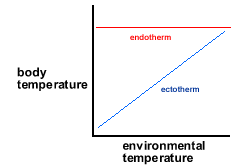15.2 thermoregulation
process of maintaining relatively constant core body temperature → important to maintain optimum enzyme activity
ectotherms | endotherms | |
examples | reptiles, fish | mammals, birds |
definition | animals that use their surroundings to regulate their body temperature | animals that rely on their metabolic processes to control their body temperature |
control of body temperature | can only regulate body temp through behavioural changes (basking in sun, seeking shade) | regulate body temperature through internal processes and behavioural changes |
variation in body temperature | internal temperature is influenced by environmental temperatures | internal temperature is relatively stable and less influenced by changes in environmental temperature |
activity level | activity increases with warmer environmental temperatures and decreases when it's cooler | can remain active across a range of temperatures |
metabolic rate | metabolic rate varies + organism generally produces minimal heat on its own | organism sustains a high and steady metabolic rate, producing large amounts of heat through metabolism |
endothermy
endotherms: ex. mammals and birds, have physiological mechanisms to maintain internal temp
can maintain body temperature
are independent of external temperatures
use internal sources of heat to help maintain body temp
can use behavioural methods as well
thermoregulation in endotherms
endothermic animals detect external temps via peripheral receptors (thermoreceptors found in skin + mucous membranes)
these are receptors for both heat + cold
these communicate w hypothalamus to bring abt physiological response to changing external temps
hypothalamus also helps regulate body temp by monitoring temp of blood flowing throw it + initiating homeostatic responses when it gets too high/low
advantages
activity possible in cold temperatures
able to colonise colder parts of the planet thus less competition
disadvantages
most of energy intake used to maintain temp in cold environments
more food required
less energy used in growth
cycle
temperature increases
thermoreceptors detect temp is too hot
thermoreceptors send info to thermoregulatory centre to organise response (nervous system). brain → hypothalamus
effectors produce response that will decrease temp
temp decreases
thermoreceptors detect temp too low
thermoreceptors send info to thermoregulatory centre to organise response (nervous system). brain → hypothalamus
effectors produce responses that will increase temp
back to stage one
warming up
to raise body temp:
increase respiration rate
rapidly contract muscles (shivering)
contract piloerector muscles which raise hairs/feathers, trapping layer of insulating air next to skin
seek shelter/insulating materials
cooling down
to lower body temp:
reduce movements
sweat
relax piloerector muscles sp hairs/feathers lie flat on skin
conduction | lie on cold ground staying in cold water covering in cool mud |
convection | climb to lower ground, valleys, burrows enter cold water or air current building nest/burrow with air/water flow |
radiation | finding shade entering burrow shapd for radiation |
ectothermy
ex. reptiles, amphibians, fish + invertebrates interact with environment to survive + thrive

cannot maintain body temp efficiently and rely on external temp to keep warm
don’t use internal heat sources to maintain temperature however, once active, muscle contractions will generate heat.
advantages
use less of their food in respiration
need to find less food
greater proportion of food used in growth
disadvantages
less active in cool temps
need to warm up before becoming active - high threat of predation
not capable of activity in winter
must have sufficient sources of energy for these months
behavioural changes
mainly use behavioural changes to regulate body temp, relying on external sources heat to warm up
physically move between warmer + cooler areas
show basking behaviour - flatten bodies against surfaces to gain more radiant heat when cold
saving energy
bc expend less energy on internal maintenance of body temp than endotherms, more energy they obtain from food can be used for growth
role of the hypothalamus in controlling body temperature
hypothalamus = brain’s thermostat, crucial in coordinating thermoregulation in mammals
2 control centres in thermoregulation: heat loss + gain centre
when blood temp increases:
impulses sent to heat loss centre in hypothalamus
this sends impulses to effector organs to ↑ heat loss
body temp returns to optimum point
when blood temp decreases:
impulses sent to heat gain centre in hypothalamus
this sends impulses to effector organs to ↓ heat loss
body temp returns to optimum point
hypothalamus is important part of brain for thermoregulation bc:
hypothalamus collects info abt core body temp from temp receptors in hypothalamus + about surface temp from peripheral receptors in skin
info processed in hypothalamus to detect deviations from normal levels in core + surface body temp
hypothalamus sends signals to effectors ex. muscles, sweat glands
effectors implement mechanisms to restore ideal temp
lets mammals maintain stable internal temp, even if external temp fluctuate